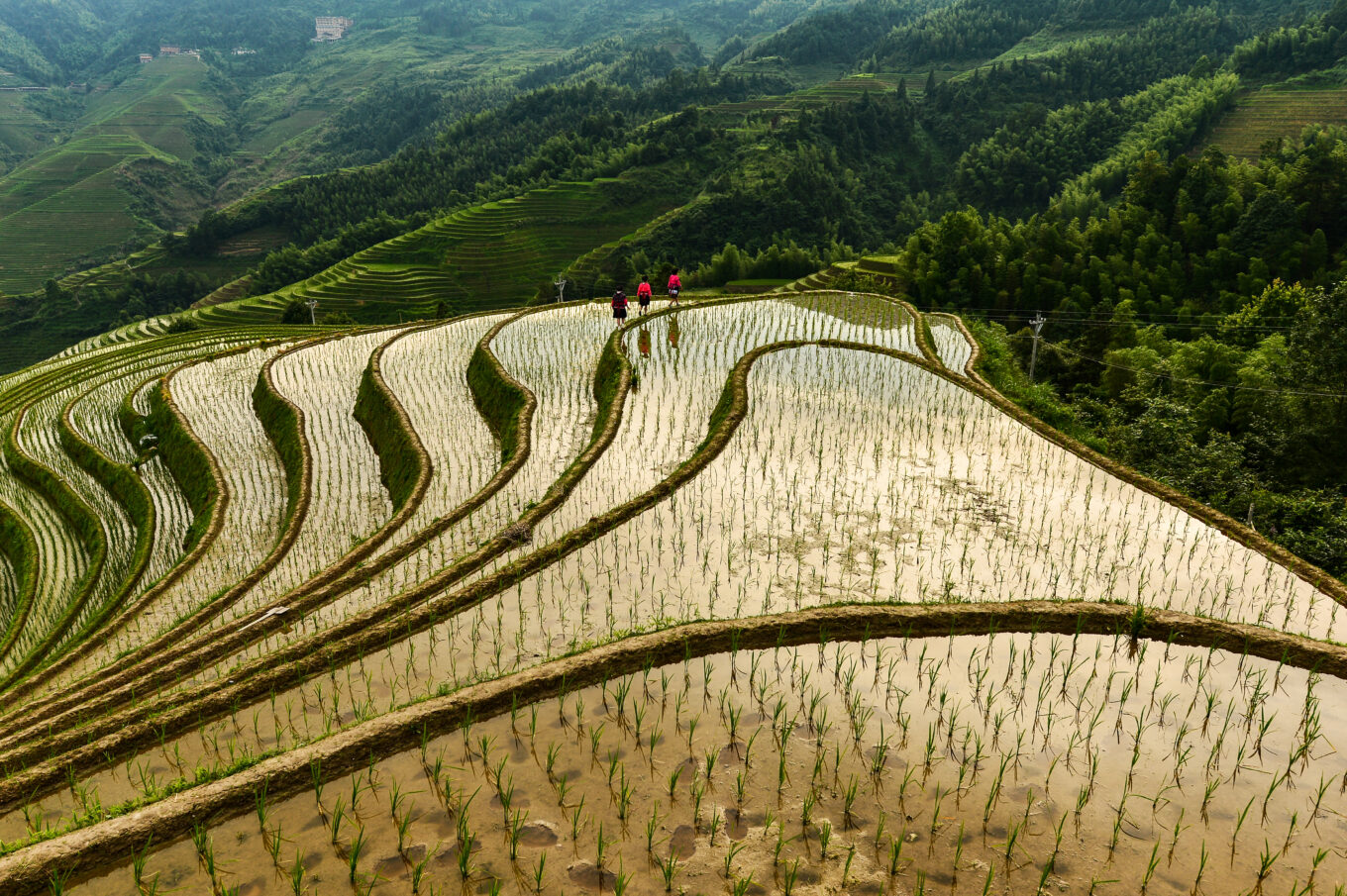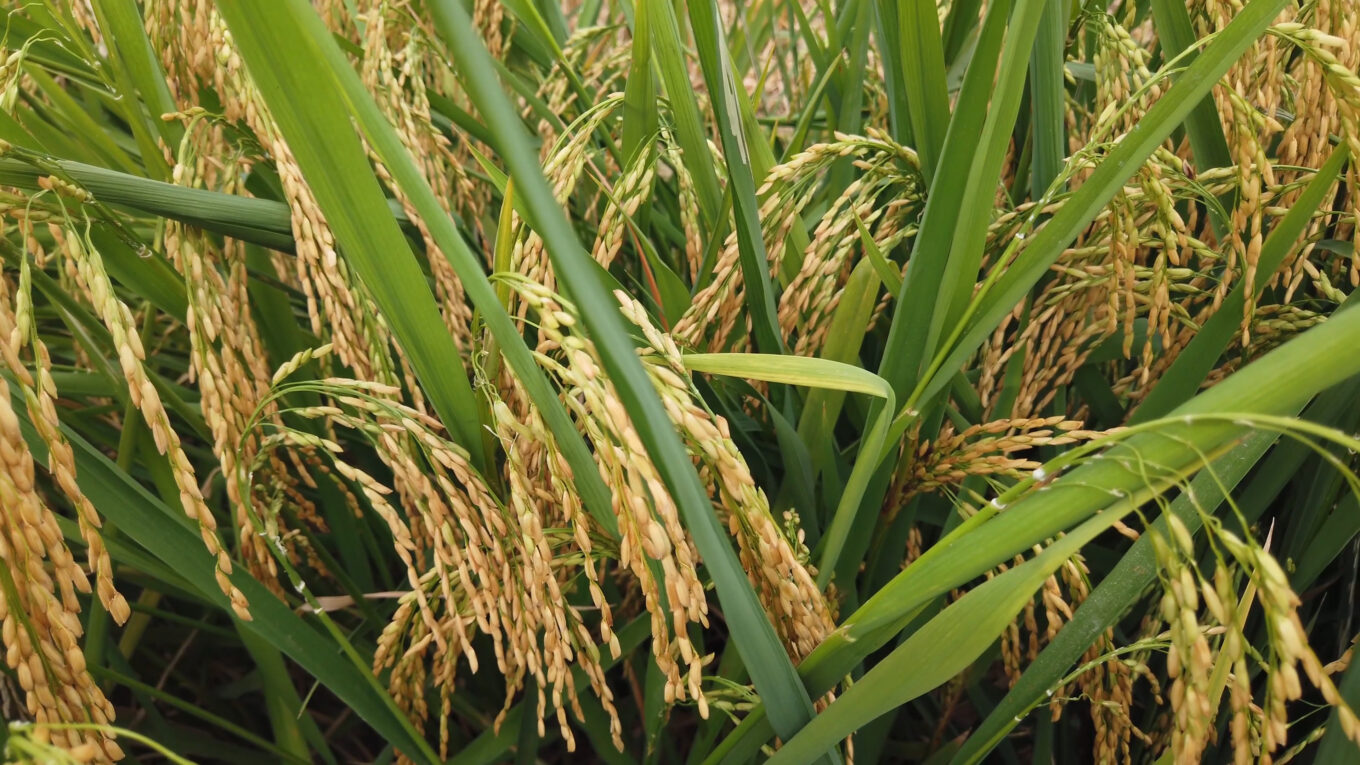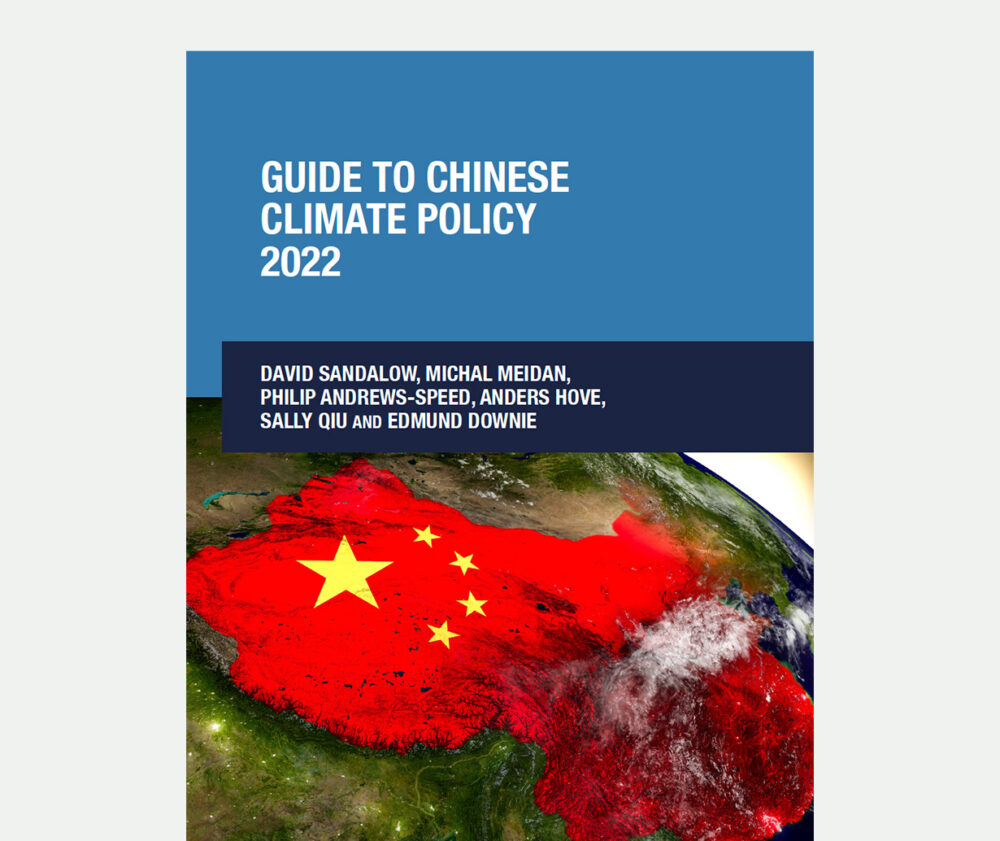China is the world’s largest producer and consumer of food products. In 2019, China’s food system produced roughly 1.9 billion tonnes of CO2eq emissions within China—approximately 13.5% of China’s total emissions of heat-trapping gases.1
The food system spans a vast array of activities, including land clearing, fertilizer manufacturing, crop cultivation, livestock production, fish harvesting, meal preparation and landfill management. It includes food production, transport, processing, packaging, storage, consumption and disposal. Globally, the food system contributes more than 30% of heat-trapping gas emissions each year.2
This chapter provides background on China’s food system, emissions of heat-trapping gases and policies related to food system emissions.
BACKGROUND
Production
China is the world’s largest producer of agricultural products. In 2020, China was the world’s largest producer of seed cotton (35.5%), rice (28%) and wheat (18%) and the second-largest producer of corn (22%). (In contrast, China produced only 5.5% of the world’s soybeans, far behind the United States, Brazil and Argentina.)3
China also leads the world in production of fish and pork. In 2019, 37% of global fish production was in China. In 2020, 38% of global pork production, 13% of global chicken production and 9% of global beef production were in China.4
Roughly a quarter of China’s employment and 8% of its GDP is in the agriculture sector. Agriculture’s share of China’s GDP has been gradually declining during the past several decades.5
In 2019, agricultural activities were responsible for 1.8% of energy consumption in China, including 0.5% of coal consumption, 2% of gasoline consumption and 10% of diesel oil consumption.6

Rice Terrace in Guilin China

Close up view of rice-plants as a cereal grain
Consumption
The most consumed agricultural products in China include vegetables, cereals, fruits, starchy roots and oil crops.7
In 2019, China had roughly 64 kilograms of meat per capita for food supply, approximately half that of the United States and Australia but higher than the world average.8 Between 1975 and 2018, China’s meat consumption increased 14-fold. (Grain consumption tripled during the same period.)9 China is the world’s largest consumer of pork.10
Trade
China is a net food importer and plays a central role in the international agricultural trade.
Between 2017 and 2020, China was the world’s largest importer of agricultural products, followed by the United States.11 In 2021, China imported $219.8 billion of agricultural products, including $53.5 billion of soybeans, $32.2 billion of meat products, $15.2 billion of fruits and nuts and $14.4 billion of aquatic products.12
Between 2015 and 2020, China was the world’s fifth largest exporter of agricultural products, behind the United States, Netherlands, Brazil and Germany.13 In 2021, China exported a total of $84.4 billion of agricultural goods, including $21.6 billion of aquatic products, $12.3 billion of vegetables and $6.1 billion of fruits and nuts.14
Emissions of Heat-Trapping Gases
Emissions of heat-trapping gases are generated throughout the food system. The world’s leading data source on this topic—the UN Food and Agriculture Organization (FAO)—divides food system emissions into three categories: farm-gate, land use change, and pre- and post-production activities. (The latter category includes fertilizer manufacturing, food household consumption, food packaging, food processing, food retail and food transport.)
According to FAO, in 2019:
- farm-gate emissions in China were roughly 792 Mt CO2eq total (approximately 6% of total Chinese emissions);
- there were no emissions due to agricultural land use change in China; and
- pre- and post-production activity emissions in China were 1.1 Gt CO2eq (approximately 8% of total Chinese emissions).15
These totals included emissions of roughly 469 Mt CO2eq from household food consumption, 210 Mt CO2eq from food waste disposal and 131 Mt CO2eq from fertilizer manufacturing.16
Emissions Footprint of China’s Food System Abroad
China’s food imports contribute to emissions of heat-trapping gases abroad. One study found that Chinese soy imports were responsible for 6.5 Mt of CO2 emissions linked to deforestation in Brazil in 2017.17 Another study found 12 Mt of CO2eq emissions in exporting countries from China’s import of ruminant products in 2012.18 In contrast with the industrial sector, where consumption-based emissions accounting reduces China’s emissions totals as compared to traditional territorial-based emissions accounting, in the food sector consumption-based emissions accounting increases China’s emissions totals.19
POLICY
For almost two decades, the first policy document issued by China’s State Council each year has been on rural issues. The No. 1 Central Document (as it is known) generally focuses on three issues—the rural population, rural areas and agriculture. The most recent No.1 Central Document, released in February 2022, calls for:
- stabilizing and increasing agricultural productivity;
- steadily raising farmers’ incomes; and
- ensuring stability in rural areas to cope with the COVID-19 pandemic and other changes.
The No. 1 Central Document for 2022 focuses in particular on grain security, calling for new measures to ensure that grain production does not fall below 650 billion kilograms.20
The No.1 Central Document for 2014 was the first to propose a long-term framework for sustainable agricultural development. The framework focused on water usage, pesticides and chemical fertilizers, among other issues—not directly on climate change.21 Similarly, the National Sustainable Agricultural Development Plan (2015–2030), released by the Ministry of Agriculture in May 2015, focused on agricultural productivity, water usage and chemical pollution, without specific goals related to climate change mitigation or adaptation.22 However in the months and years since, Chinese government policy documents have paid growing attention to the relationship between agriculture and climate change.
In June 2015, for example, the Chinese government submitted its Intended Nationally Determined Contribution (INDC) to the UN Framework Convention on Climate Change (UNFCCC). The INDC describes plans to:
- promote low-carbon development in agriculture;
- make efforts to achieve zero growth of fertilizer and pesticide utilization by 2020;
- control methane emissions from rice fields and nitrous oxide emissions from farmland;
- construct a recyclable agriculture system by promoting comprehensive utilization of straw, agricultural and forestry wastes, and animal wastes; and
- improve greenhouse gas emissions statistics covering areas including agriculture.23
In December 2016, the Ministry of Agriculture and Ministry of Finance jointly issued the Plan for Establishing a Green and Ecologically Oriented Agricultural Subsidy System. The plan promotes the rational use of agricultural resources in accelerating sustainable agricultural development and agricultural modernization. The plan emphasizes that incremental funds should focus on resource-saving and environment-friendly agriculture.24
In December 2018, China released its Second Biennial Update Report on Climate Change and the Third National Communication on Climate Change. Regarding agriculture, the documents report that China had:
- enhanced energy conservation for agricultural operation and rural buildings;
- implemented the goal for zero growth in the use of chemical fertilizers and pesticides;
- controlled pollution and non-CO2 GHG emissions from farming through biogas utilization; and
- increased capacity for climate change adaptation technologies, including water-saving technology and breeding of stress-resistant agricultural varieties.25
In November 2019, the Ministry of Ecology and Environment released its annual report on China’s Policies and Actions for Addressing Climate Change. The report discussed climate mitigation and adaptation issues related to China’s agriculture sector. According to the report:
- demonstrations of chemical fertilizer use reduction had been conducted in 300 counties, reducing the chemical fertilizer use rate of three major crops by 37.8%;
- waste utilization from livestock and poultry had been promoted in 585 counties, resulting in a 70% comprehensive utilization rate of waste resources nationwide;
- localities had been developing water-saving agriculture, promoting drought-resistant and moisture-conserving adaptation technologies, and cultivating high-temperature resistant and drought-resistant crop varieties.26
In August 2020, President Xi Jinping announced the “Clean Plate Campaign” to enhance the public’s awareness of food waste.27 (Wasted food results in significant emissions of heat-trapping gases.)28 The campaign highlights the need to maintain a sense of crisis regarding food security during the COVID-19 pandemic and calls for promoting the social custom of thrift. Food distributors have responded with a range of measures, including restaurants offering half-portion options, universities rewarding students with free fruit for finishing their lunch, and catering companies allowing a group of 10 diners to order only nine dishes.29
In March 2021, the China government released its 14th Five-Year Plan for Economic and Social Development and Long-range Objectives through the Year of 2035. With respect to the food system, the plan calls for:
- modernizing the agricultural sector by 2035;
- accelerating the development of smart agriculture and promoting the digital transformation of agricultural production;
- building a national food security industry belt;
- promoting water-saving renovation; and
- promoting the green transformation of agriculture and strengthening environmental protection of agricultural production areas.30
In April 2021, the National People’s Congress passed the Anti-Food Waste Law. The law outlines the basic code of conduct for entities including government, enterprises, schools and the food/catering services to improve food procurement, management and preparation processes. Most notably, the law allows restaurants to charge diners an extra fee (if clearly advertised) for leaving excessive amount of food uneaten. Food providers who mislead consumers into making excessive orders could face fines up to RMB 10,000 (roughly $1500). The law also bans making and distributing binge-eating videos.31
In October 2021, the National Development and Reform Commission (NDRC) released the Action Plan for Carbon Dioxide Peaking Before 2030, following the Working Guidance for Carbon Dioxide Peaking and Carbon Neutrality in Full and Faithful Implementation of the New Development Philosophy. On agriculture, the plans call for:
- developing energy-saving, low-carbon greenhouses for agriculture;
- promoting the use of energy-saving, eco-friendly cookers, agricultural machinery, fishing boats and agricultural vehicles;
- speeding up the application of renewable energy resources, such as biomass energy and solar energy, in agricultural production and daily life in rural areas;
- stepping up efforts to develop green, low-carbon and circular agriculture and support low-carbon modes such as agricultural photovoltaics and the combination of offshore wind farms and marine ranches;
- researching applied agricultural technologies that can increase carbon sequestration;
- improving the quality of cropland to protect chernozem soils and to enhance soil organic carbon content; and
- controlling the use of chemical fertilizers, pesticides and agricultural plastic sheeting.32
In October 2021, the Chinese government submitted its updated Nationally Determined Contributions to the UNFCCC. The document discusses China’s progress in curbing emissions of heat-trapping gases in the agricultural sector and improvements in the quality of agricultural production.33
The document includes emissions reduction and efficiency improvement in agriculture among the new measures for implementing the updated NDC goals, citing measures to:
- enhance the reduction and efficiency of chemical fertilizers and pesticides;
- refine the treatment and utilization of livestock and poultry manure;
- adjust planting structure based on the endowment of water resources; and
- select, test and demonstrate energy-saving and emission-reduction technology in agriculture and fishery.34
The document discusses the importance of climate change adaptation for agriculture, calling for strategies to optimize agricultural structure and research on agro-meteorological disaster prevention technologies.35
In June 2022, the Ministry of Agriculture and Rural Affairs and the NDRC jointly issued the Implementation Plan for Emission Reduction and Carbon Sequestration in Agriculture and Rural Areas. In alignment with the carbon peaking and carbon neutrality goals, the plan identifies 10 major action areas, including: methane reduction in rice fields, fertilizer reduction and efficiency enhancement, carbon emission reduction from livestock and poultry, sink improvement in fishery, energy conservation in agricultural machinery, sink improvement in farmland, comprehensive utilization of straw, renewable energy replacement, science and technology innovation support, and monitoring system implementation.36
References

